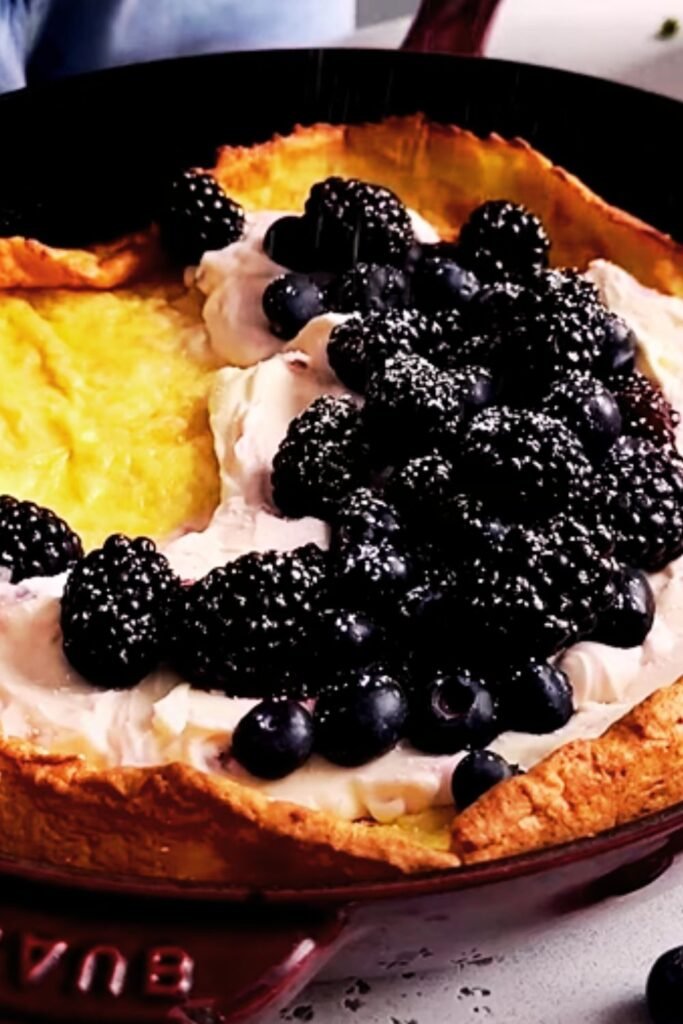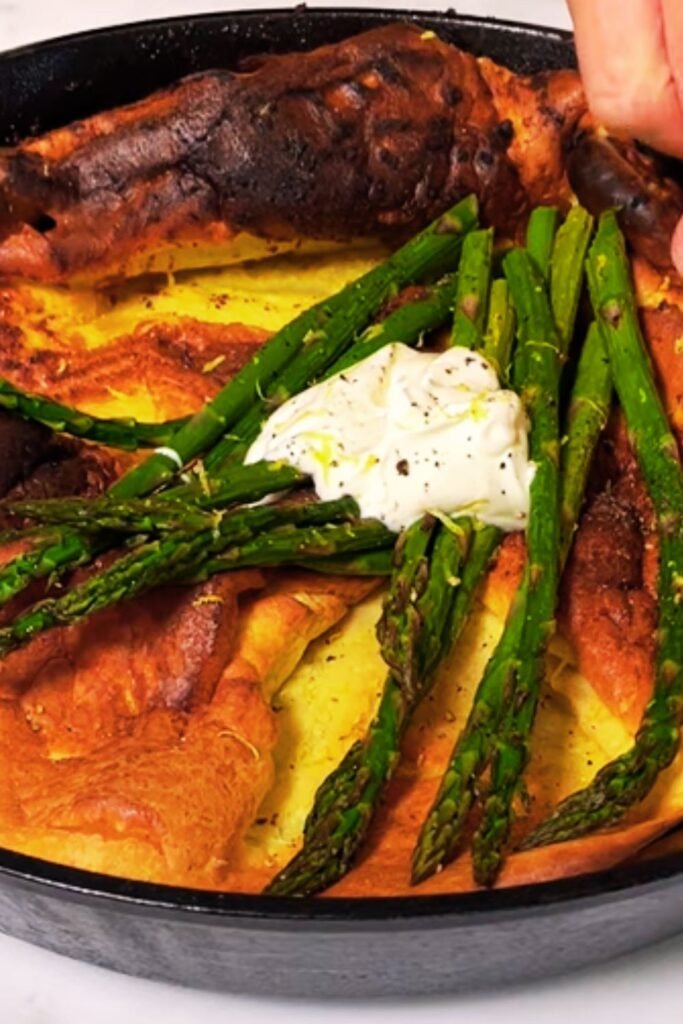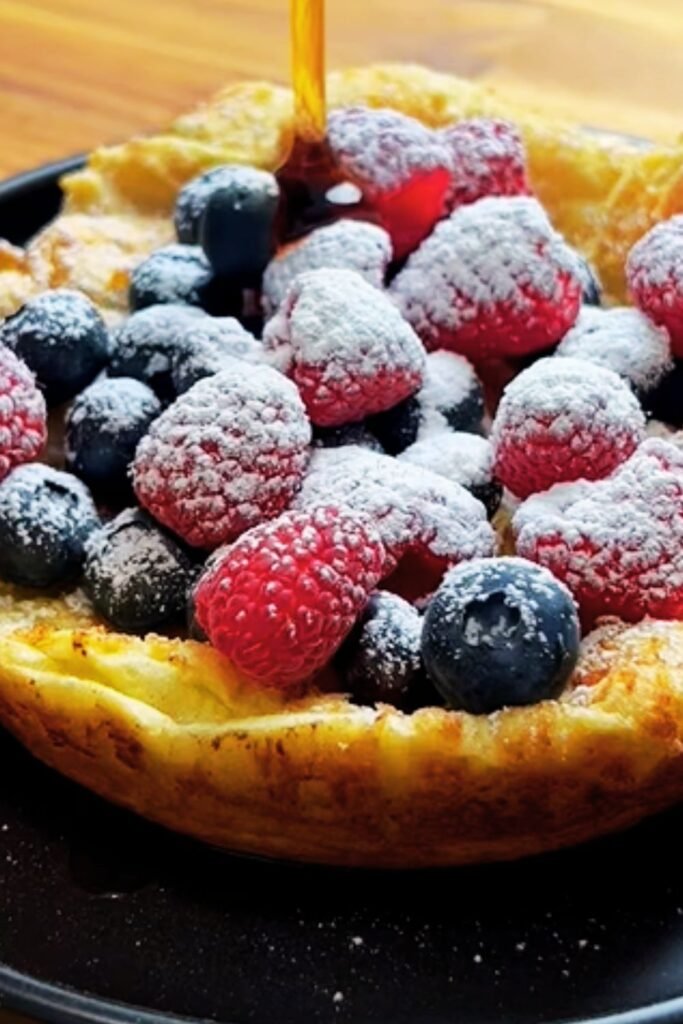There’s something magical about a Dutch baby pancake as it rises dramatically in the oven, creating golden peaks and valleys that cradle whatever delicious toppings you choose. I’ve experimented with dozens of Dutch baby recipes over the years, but this vanilla bean version paired with a vibrant strawberry hibiscus syrup has become my absolute favorite weekend breakfast treat. The contrast between the custardy pancake infused with fragrant vanilla beans and the tangy-sweet strawberry syrup creates a breakfast experience that feels both comforting and special.
What Makes a Dutch Baby So Special?
For those unfamiliar with this delightful breakfast creation, a Dutch baby (also known as a German pancake) is essentially a large, puffy pancake that’s baked in a hot skillet instead of cooked on a stovetop. The batter is similar to that of a popover or Yorkshire pudding—a simple mixture of eggs, flour, milk, and sugar that transforms dramatically in the oven.
What I love most about Dutch babies is their versatility. They provide the perfect canvas for both sweet and savory toppings, though today we’re firmly in sweet territory with our vanilla bean and strawberry hibiscus combination.
The Perfect Dutch Baby Formula
Through countless Sunday mornings of testing, I’ve discovered the secrets to creating that perfect Dutch baby rise:
- Temperature matters: Both the pan and the ingredients need to be at the right temperature
- Rest the batter: Allowing the batter to rest helps the flour hydrate properly
- Don’t peek!: Resist the urge to open the oven door during baking
- Timing is everything: Serve immediately for maximum wow-factor
Now, let’s dive into creating this breakfast masterpiece that’s sure to impress anyone lucky enough to be at your breakfast table.
Ingredients
For the Vanilla Bean Dutch Baby:
- 3 large eggs, room temperature
- ⅔ cup whole milk, room temperature
- ⅔ cup all-purpose flour
- 1 tablespoon granulated sugar
- 1 vanilla bean, split and seeds scraped (or 2 teaspoons pure vanilla extract)
- ¼ teaspoon fine sea salt
- 2 tablespoons unsalted butter
- Powdered sugar, for dusting
For the Strawberry Hibiscus Syrup:
- 1 pound fresh strawberries, hulled and quartered (frozen works too)
- ⅓ cup granulated sugar
- 2 tablespoons dried hibiscus flowers (or 2 hibiscus tea bags)
- 2 tablespoons fresh lemon juice
- ¼ cup water
- Pinch of salt
Equipment You’ll Need
- 10-inch cast iron skillet (or oven-safe skillet)
- Blender or food processor
- Fine mesh strainer
- Small saucepan
- Measuring cups and spoons
- Mixing bowls
- Whisk
- Spatula
Making the Perfect Dutch Baby: Step by Step
Preparing the Batter
- Place your cast iron skillet in the oven and preheat to 425°F (220°C). The hot skillet is crucial for creating that dramatic puff.
- In a blender, combine the eggs, milk, flour, sugar, vanilla bean seeds, and salt. Blend on medium speed for about 30 seconds until smooth. If you don’t have a blender, whisk vigorously by hand until no lumps remain.
- Let the batter rest for 15-20 minutes at room temperature. This resting period allows the flour to fully hydrate and the gluten to relax.
- When the oven reaches temperature, carefully remove the hot skillet (remember, it’s scorching!). Add the butter and swirl to coat the entire bottom and sides as it melts.
- Immediately pour the batter into the center of the hot, buttered skillet. Work quickly but carefully.
- Return the skillet to the oven and bake for 18-20 minutes until the Dutch baby is puffed dramatically and golden brown along the edges.

The Rise and Fall
Don’t be alarmed when your beautiful Dutch baby begins to deflate almost immediately after removing it from the oven—this is completely normal! The dramatic rise comes from steam trapped in the batter, which escapes once the pancake is removed from the heat source. The deflated Dutch baby creates the perfect vessel for holding our strawberry hibiscus syrup.
Crafting the Strawberry Hibiscus Syrup
While your Dutch baby batter is resting, prepare the syrup:
- In a medium saucepan, combine the strawberries, sugar, hibiscus flowers, lemon juice, water, and salt.
- Bring the mixture to a gentle boil over medium heat, then reduce to a simmer and cook for about 10-12 minutes, occasionally mashing some of the strawberries with a wooden spoon or spatula.
- Remove from heat and let steep for 5 minutes to allow the hibiscus to fully infuse.
- Strain the mixture through a fine-mesh sieve into a clean bowl, pressing gently on the solids to extract all the flavorful syrup. Reserve some of the cooked strawberry pieces to serve alongside if desired.
- Return the strained syrup to the saucepan and simmer for another 5 minutes to thicken slightly. The syrup will continue to thicken as it cools.
The hibiscus flowers add a stunning ruby color and a subtle tartness that complements the sweetness of the strawberries perfectly. If you can’t find dried hibiscus flowers, two hibiscus tea bags work just as well—simply steep them in the hot strawberry mixture and remove before straining.

Serving Suggestions
For the ultimate presentation:
- Dust the Dutch baby with powdered sugar immediately after removing from the oven.
- Drizzle generously with warm strawberry hibiscus syrup.
- Top with:
- Fresh strawberry slices
- A dollop of whipped cream or crème fraîche
- Fresh mint leaves for a pop of color
- A sprinkle of finely grated lemon zest
Additional accompaniments that pair beautifully include:
- Fresh blueberries or raspberries
- Toasted sliced almonds
- A drizzle of good-quality honey
- Greek yogurt with a touch of vanilla
Make-Ahead Options
While a Dutch baby is best served fresh from the oven, you can prepare components ahead of time:
The night before:
- Mix the dry ingredients
- Prepare the strawberry hibiscus syrup and refrigerate (reheat gently before serving)
In the morning:
- Add wet ingredients to the dry mixture
- Rest the batter while the oven preheats
- Bake fresh for breakfast
The Science Behind the Perfect Dutch Baby
I’ve always been fascinated by the science of cooking, and Dutch babies are a perfect example of culinary chemistry in action. The dramatic rise comes from the rapid expansion of air and steam trapped in the egg proteins. Here’s what’s happening:
| Factor | Role in Dutch Baby Success | Common Mistakes |
|---|---|---|
| Egg Temperature | Room temperature eggs incorporate more air when mixed | Using cold eggs straight from refrigerator |
| Hot Pan | Creates immediate steam when batter hits surface | Starting with a cold or lukewarm pan |
| Oven Temperature | High heat (425°F) causes rapid expansion | Temperature too low or opening the oven door |
| Batter Consistency | Thin enough to spread but with enough protein structure | Too thick (too much flour) or too thin (too much liquid) |
| Resting Time | Allows flour to hydrate and gluten to develop slightly | Skipping the rest period |
Troubleshooting Common Dutch Baby Problems
Even experienced bakers sometimes encounter issues with Dutch babies. Here are solutions to common problems:
Problem: Dutch baby didn’t rise properly
Solution: Ensure your oven is fully preheated, your skillet is scorching hot before adding batter, and you’re using room temperature ingredients.
Problem: Dutch baby is too dense
Solution: Check your flour measurement (too much flour creates density) and make sure you’re not overmixing the batter.
Problem: Dutch baby collapsed immediately
Solution: Some collapse is normal, but excessive deflation might mean undercooking. Add 1-2 minutes to baking time.
Problem: Syrup is too thin
Solution: Simmer the strained syrup a few minutes longer to reduce and thicken.

Variations to Try
Once you’ve mastered the classic vanilla bean Dutch baby, feel free to experiment with these delicious variations:
Lemon Blueberry Dutch Baby
Replace vanilla bean with lemon zest in the batter and top with fresh blueberries and lemon curd.
Chocolate Dutch Baby
Add 2 tablespoons of cocoa powder to the batter and serve with chocolate sauce and raspberries.
Savory Herb and Cheese Dutch Baby
Omit the sugar and vanilla, add chopped fresh herbs and grated Parmesan to the batter, and top with roasted vegetables.
Apple Cinnamon Dutch Baby
Add cinnamon to the batter and sauté thinly sliced apples in butter and brown sugar to create a caramelized topping.
Dietary Adaptations
Need to adjust for dietary restrictions? Here are some tested alternatives:
Gluten-Free Dutch Baby
Substitute all-purpose flour with a 1-to-1 gluten-free flour blend. Add ¼ teaspoon of xanthan gum if your blend doesn’t include it.
Dairy-Free Option
Replace whole milk with almond or oat milk and use coconut oil instead of butter.
Reduced-Sugar Version
Decrease sugar in both the batter and syrup by half and rely on the natural sweetness of fresh strawberries.
The Complete Nutritional Breakdown
For those watching their intake, here’s a breakdown of what you can expect per serving (assuming 4 servings per Dutch baby):
| Nutrient | Amount per Serving | % Daily Value |
|---|---|---|
| Calories | 295 | – |
| Total Fat | 14g | 18% |
| Saturated Fat | 7g | 35% |
| Cholesterol | 170mg | 57% |
| Sodium | 185mg | 8% |
| Total Carbohydrates | 35g | 13% |
| Dietary Fiber | 2g | 7% |
| Total Sugars | 18g | – |
| Protein | 8g | 16% |
| Vitamin D | 1mcg | 5% |
| Calcium | 80mg | 6% |
| Iron | 1.5mg | 8% |
| Potassium | 220mg | 5% |
Note: Values are approximate and may vary based on specific ingredients used.
Why I Love This Recipe
Every time I make this vanilla bean Dutch baby, I’m transported back to the first time I tried one at a small breakfast café in Portland. There was something magical about watching that puffy, golden creation arrive at the table, still steaming from the oven. I’ve spent years perfecting my own version, and this recipe—with its aromatic vanilla bean and the vibrant strawberry-hibiscus syrup—has become my signature breakfast dish.
What I appreciate most about Dutch babies is their ability to feel both homey and sophisticated at the same time. They’re simple enough for a cozy Sunday morning but impressive enough for a special brunch with friends. And while they look complicated, they’re actually much easier than making individual pancakes!
The strawberry hibiscus syrup elevates this dish from delicious to memorable. The hibiscus adds a subtle floral tartness that balances the sweet strawberries perfectly, while also creating that stunning ruby color that makes this dish as beautiful as it is delicious.
Frequently Asked Questions
Q: Can I make Dutch baby batter the night before?
A: Yes, you can prepare the batter the night before and refrigerate it. Just be sure to bring it to room temperature before baking (about 30 minutes on the counter) for the best rise.
Q: I don’t have a cast iron skillet. What else can I use?
A: Any oven-safe skillet will work, though cast iron gives the best results due to its heat retention properties. A well-seasoned carbon steel pan or even a pie plate in a pinch can work too.
Q: Why did my Dutch baby develop one giant bubble on one side?
A: Uneven heating or pouring the batter off-center can cause lopsided rising. Make sure your oven heats evenly and pour the batter directly into the center of the pan.
Q: Can I use vanilla extract instead of a vanilla bean?
A: Absolutely! Use 2 teaspoons of pure vanilla extract instead of the vanilla bean. The flavor won’t be quite as intense, but it will still be delicious.
Q: Is there a way to keep a Dutch baby puffy longer?
A: Unfortunately, the dramatic deflation is part of the Dutch baby experience. The soufflé-like rise is temporary, but the flavor remains delicious even after it falls.
Q: How do I know when my Dutch baby is done?
A: A properly cooked Dutch baby should be puffed up with golden brown edges and a slightly custardy center. If you’re unsure, an instant-read thermometer inserted in the center should read about 200°F (93°C).
Q: Can I freeze leftover Dutch baby?
A: While not ideal, you can freeze leftover portions. Wrap tightly and freeze for up to 1 month. Reheat in a 350°F oven until warmed through, about 5-8 minutes.
Final Thoughts
Creating a perfect Dutch baby pancake is a delightful way to elevate your breakfast or brunch game. The dramatic puff as it bakes and the versatile nature of the recipe make it one of my all-time favorite morning treats. When paired with the vibrant strawberry hibiscus syrup, this vanilla bean Dutch baby becomes something truly special—a breakfast worthy of celebrations but simple enough for everyday indulgence.
I hope you’ll try this recipe and experience the joy of watching your own Dutch baby rise in the oven. And once you’ve mastered the basic technique, I encourage you to experiment with your own favorite flavors and toppings. The possibilities are endless, and each variation brings its own unique charm to your breakfast table.
Remember, the key to Dutch baby success lies in those hot temperatures (both oven and skillet), room temperature ingredients, and that crucial rest period for the batter. Follow these principles, and you’ll be rewarded with a breakfast that’s as impressive as it is delicious.
Happy baking!